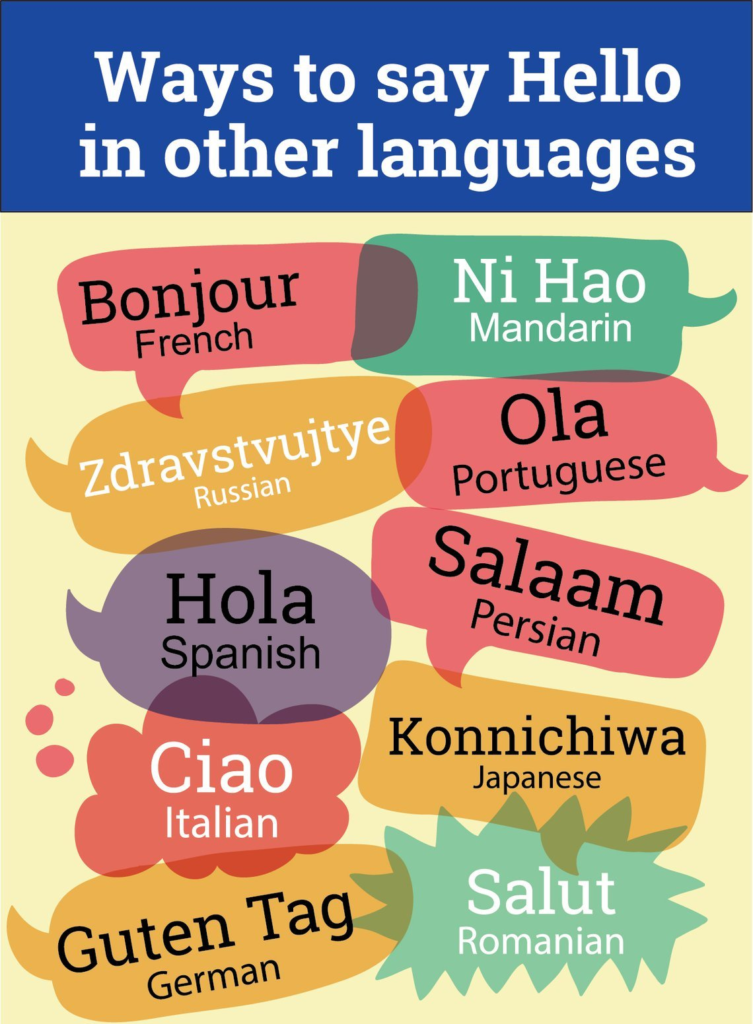
Table of Contents
- How to Say Hello in 10 Different Languages
- Conclusion
- FAQs
The most frequently used word while communicating in the English language undoubtedly is “Hello.” Hello is an important part of our everyday greeting. But that does not hold true for just English. Every language has a separate word for Hi or Hello that is commonly used and is yet so meaningful and essential for everyday communication. At some point or the other, you must have run out of synonyms for “Hello” or Googled new words to greet people. Wouldn’t it be so interesting if you knew how to say Hello in different languages?
How to Say Hello in 10 Different Languages
Here is a quick guide on how to say hello in different languages. Let’s take a look at the words used in place of Hello in other languages.

1. Hola in Spanish
One of the most common answers to how to say hello in different languages is the Spanish word “Hola” (oh-la). With a friendly yet formal connotation attached to it, Hola is a versatile greeting. The word Hola literally translates to Hi. If you want to use it in a more informal sense, there are other Spanish equivalents for that like, Que Tal? (What’s up), Que Pasa? Que Onda? etc.
2. Konnichi Wa in Japanese
Another popular form of hello is the Japanese greeting phrase Konnichi Wa, spoken as kon-neen-chee-wah. The exact translation of the phrase is “hello.” It is an extremely respectful and courteous way of greeting someone, in Japanese.
3. Guten Tag in German
Guten Tag is pronounced as “gooten-taag,” it is the German word for hello and has a formal connotation to it.

And the word accompanying “Guten” changes as per the time of the day, when one is greeting a person. “Guten Abend” is used for “good evening.” In case you are saying hello to close friends or known associates, then “Hallo” is a better German term for greeting.
4. As-salam (ala-kyum) in Arabic
A beautiful phrase for greeting, the word for Hello in Arabic is as-salam (ala-kyum). It is an informal version of Hello. The literal translation of the phrase is very poetic and means- peace upon you.
5. Namaste in Hindi
Next is the Hindi word for hello or hi. Namaste or Namaskara, a combination of Sanskrit terms, is an extremely courteous greeting in India. It is associated with respect and acknowledgment of the individual you are greeting. The pronunciation for Namaste is naa-mus-tey. The word “Namah” means I bow respectfully in front of you.
6. Ciao in Italian
This Italian phrase is intended for both hello and goodbye. Pronounced as chao, the usage of Ciao depends on what time of the day you are greeting someone.

Another Italian phrase that can also be used for greeting is, Buongiorno, which stands for “good day.” If you meet a friend, a more casual way to say hello in Italian would be Buonosera, spoken as bwohn-ah-serra.
7. Bonjour in French
You sure must have seen or heard the French term “Bonjour” before. A stylish word for greeting someone is Bonjour pronounced as bo-joor. This is by far one of the most commonly used phrases on the list of how to say hello in different languages. The word “bon” means good. So literally translated, bonjour, refers to good day. A more casual way of saying hello in French is “Salut.” Though keep in mind, if you greet someone in the evening, it will be more fit to use “Bonsoir” (good evening).
8. Salve in Latin
In the language of the Roman empire, the word for hello is Salve. When talking to one individual Salve is used as a greeting, while in the case of multiple people present, “Salvete” is a more appropriate term in Latin.
9. Ni Hao in Chinese
Another great way to say hi in a different language is Ni Hao. Pronounced as nee-haow, this Chinese term for hello is more like a default greeting. Since in Chinese the pitch of your voice marks the tone of your language, stressing on different syllables of the phrase Ni Hao will depend on the different individuals you are greeting, in different contexts.
10. Shalom in Hebrew
Shalom has an almost similar translation to the Arabic equivalent for the word Hello. The term stands for peace, harmony, completeness, prosperity, welfare, and tranquility. Shalom is a word that goes beyond just the simple meaning of hello. It is used both as a formal and an informal way of greeting in Israeli communities.

Conclusion
While these are just a few ways to greet people instead of the usual hi and hello that you already use in daily conversations, you can be extremely creative with your greetings. A nice hello can have an excellent first impression. Apart from learning how to say hello in different languages, find out what your native language is and how hello is said uniquely in it, using the nuances and the colloquial terms.
FAQs
Some of the most commonly used phrases for hello, in English are hi, howdy, greetings, nice to meet you, hey, etc.
The Greek word for hello is “Yasou.” It is used for hello as well as goodbye.
Hiya is an informal way to greet someone or say hello. It is popularly used in the North of England. “Hiya” is also used as an equivalent of “let’s go.”
The Swedish word for hello is “Hej.” But there are several other terms and phrases to say hello in Swedish like “god dag,” “vad nu da,” “halla,” “hejsan,” “vad,” etc.
Latest Blogs
Explore how Google’s 2025 AI search updates triggered ranking chaos. Learn actionable strategies to adapt your SEO for AI Overviews, zero-click searches, and SERP volatility. Stay ahead now.
Learn how to rank on AI search engines like ChatGPT, Perplexity, and Gemini by optimizing your content for authority, structure, and relevance. Stay ahead in AI-driven search with this strategic guide.
Explore the best healthcare SEO services for your medical practice. Improve online visibility and effectively reach more patients in need of your services.
Get your hands on the latest news!
Similar Posts

Language
6 mins read
A Guide on How to Do Language Translation

Language
5 mins read
A Complete Guide to Advertisement Translation

Language
6 mins read